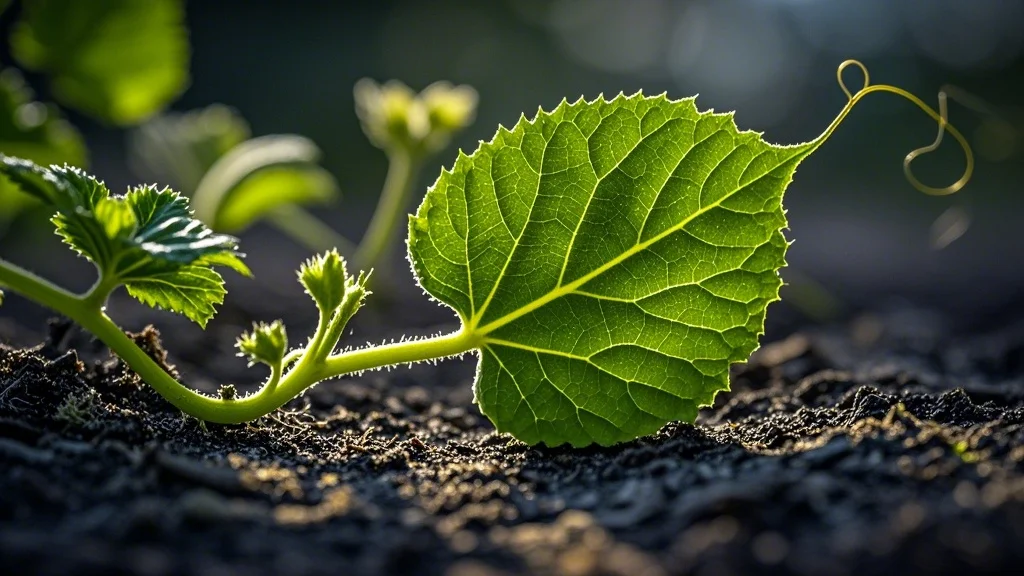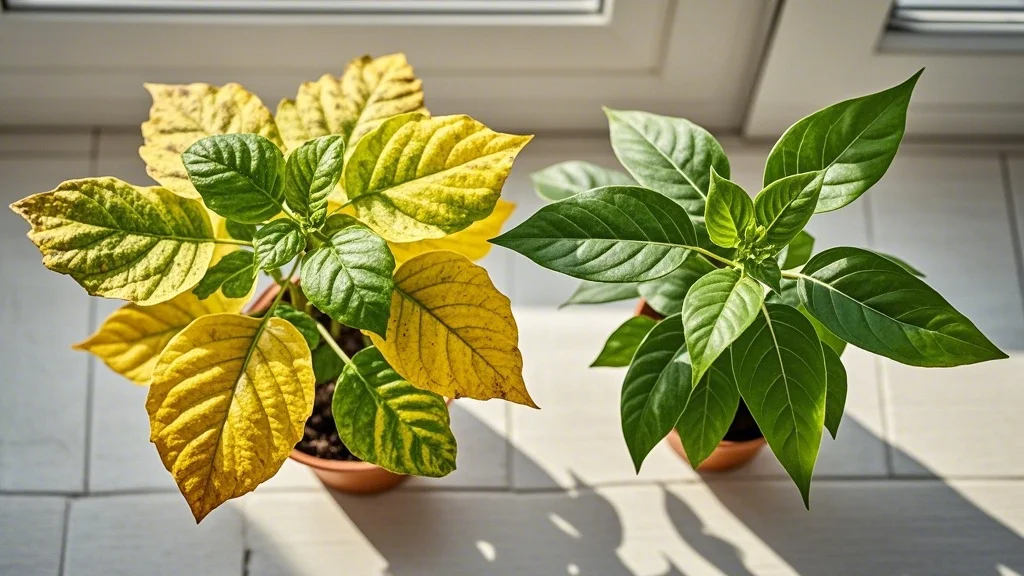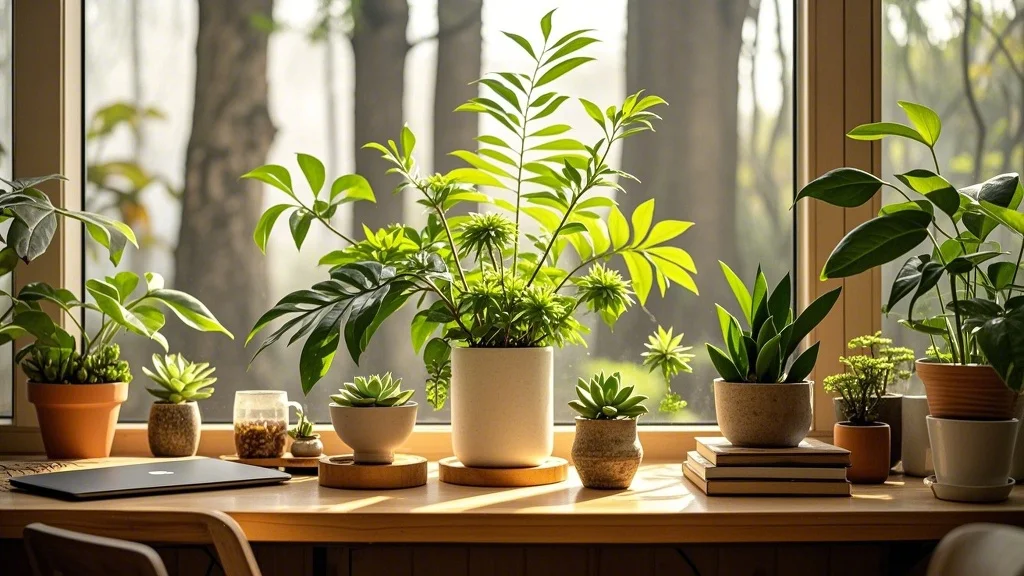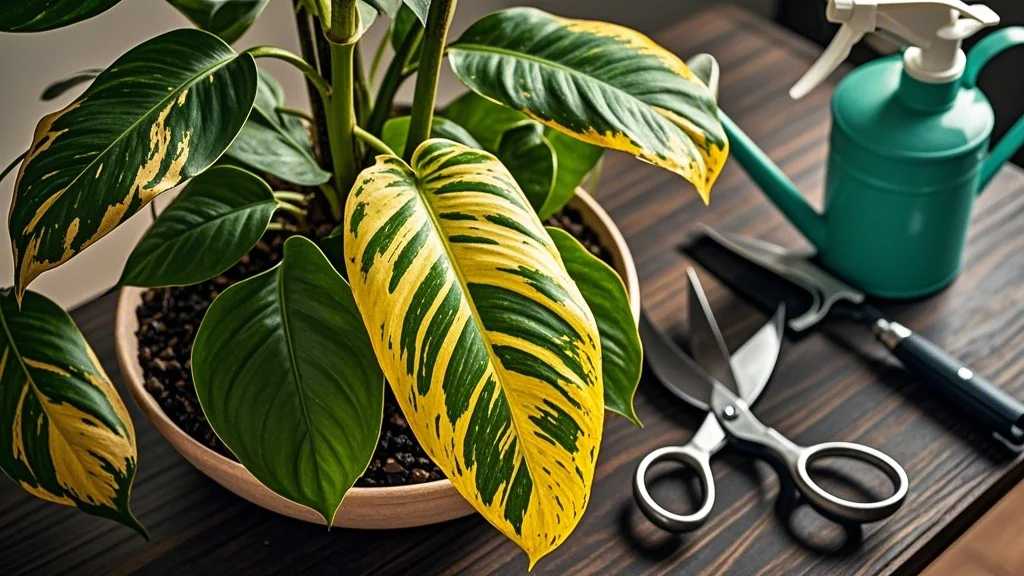For urban gardeners and houseplant enthusiasts, navigating the world of indoor plants can sometimes feel like learning a new language. From scientific terms like “etiolation” to gardening jargon like “hardening off,” understanding plant terminology is crucial for providing optimal care for your green companions. This comprehensive glossary serves as your translator in the plant world, helping you decode care instructions, identify problems, and communicate effectively with other plant lovers.
Whether you’re a beginner confused by terms on plant tags or an experienced gardener looking to expand your vocabulary, this guide will enhance your plant knowledge and ultimately contribute to healthier, thriving indoor gardens.
Contents
Basic Plant Terminology

Plant Structure Terms
Aerial Roots: Roots that grow above the soil surface, often seen in plants like pothos, monstera, and orchids. They absorb moisture and nutrients from the air.
Axil: The upper angle between a leaf and the stem from which it grows. New growth often emerges from axils.
Chlorophyll: The green pigment in plants responsible for photosynthesis, converting light energy into chemical energy.
Crown: The area where the stem meets the roots, often at soil level.
Foliage: The collective term for a plant’s leaves.
Frond: A large, divided leaf, typically used to describe fern leaves.
Node: A point on a stem where leaves, branches, or roots can emerge. Important for propagation.
Petiole: The stalk that connects a leaf to the stem.
Rhizome: A horizontal underground stem that can produce shoots and roots, common in plants like peace lilies and ZZ plants.
Stolon/Runner: A horizontal stem that grows above ground and produces new plants at the tips or nodes.
Variegation: Patterns or areas of different colors on leaves, often white, cream, yellow, or pink alongside green.
Growth and Development Terms
Annual: Plants that complete their life cycle in one growing season.
Biennial: Plants that complete their life cycle in two years, typically growing foliage the first year and flowering the second.
Deciduous: Plants that shed their leaves seasonally, usually in autumn.
Dormancy: A period of reduced growth and metabolic activity, often during winter or adverse conditions.
Etiolation: The stretching or elongation of stems due to insufficient light, resulting in pale, weak growth.
Evergreen: Plants that maintain their foliage year-round.
Hardening Off: The process of gradually acclimating plants to a new environment, particularly when moving them from indoors to outdoors.
Perennial: Plants that live for more than two years.
Propagation: The process of creating new plants from seeds, cuttings, division, or other methods.
Rootbound/Potbound: A condition where a plant’s roots have filled the pot, often circling around the inside, restricting growth.
Senescence: The natural aging process of plant parts, leading to yellowing and death of leaves.
Care and Maintenance Terminology
Soil and Potting Terms
Aeration: The presence of air pockets in soil that allow roots to breathe.
Amendment: Materials added to soil to improve its physical properties or nutrient content.
Coir: A growing medium made from coconut husks, used as an alternative to peat moss.
Compost: Decomposed organic matter used to enrich soil.
Drainage: The ability of soil to allow excess water to flow through.
Growing Medium: Any material in which plants grow, including soil, soilless mixes, water (hydroponics), or air (aeroponics).
Loam: A balanced soil mixture containing sand, silt, and clay.
Peat Moss: Partially decomposed sphagnum moss, commonly used in potting mixes to retain moisture.
Perlite: Volcanic glass that has been heated until it expands, used in potting mixes to improve drainage and aeration.
Potting Mix: A soilless medium designed specifically for container plants.
Repotting: The process of moving a plant to a new pot, often with fresh growing medium.
Soil pH: A measure of soil acidity or alkalinity on a scale of 0-14, with 7 being neutral.
Vermiculite: A mineral that expands when heated, used in potting mixes to improve water retention and aeration.
Watering and Humidity Terms
Bottom Watering: A technique where water is absorbed through drainage holes rather than applied to the soil surface.
Drought Tolerant: Plants that can survive extended periods with little water.
Humidity Tray: A shallow tray filled with water and pebbles to increase humidity around plants.
Hydroponics: Growing plants in water with added nutrients instead of soil.
Misting: Spraying fine water droplets on plant foliage to increase humidity.
Root Rot: A disease caused by overwatering that leads to decaying roots.
Self-Watering Pot: A container with a water reservoir that allows plants to absorb moisture as needed.
Transpiration: The process by which plants release water vapor through their leaves.
Water Stress: Plant damage caused by either too much or too little water.
Wicking: The movement of water through soil via capillary action.
Light and Temperature Terms
Bright Indirect Light: Strong light that doesn’t shine directly on plants, often found near windows with sheer curtains.
Cold Hardy: Plants that can tolerate low temperatures.
Direct Light: Sunlight that shines directly on plants without obstruction.
Filtered Light: Sunlight that passes through a barrier like curtains or tree leaves.
Foot-candle: A unit for measuring light intensity.
Hardiness Zone: Geographic areas defined by average annual minimum temperatures, used to determine which plants can thrive in specific regions.
Heat Stress: Plant damage caused by excessive temperatures.
Low Light: Areas with minimal natural light, such as interior rooms or north-facing windows.
Photoperiod: The duration of light exposure a plant receives daily, affecting flowering and dormancy.
Photosynthesis: The process by which plants convert light energy into chemical energy.
Shade Tolerant: Plants that can thrive in areas with minimal direct sunlight.
Fertilization and Nutrition Terms
Complete Fertilizer: Contains the three primary macronutrients (N-P-K).
Fertilizer Burn: Damage to plants caused by excessive fertilizer application.
Foliar Feeding: Applying liquid fertilizer directly to leaves for absorption.
Macronutrients: Elements needed by plants in large quantities, primarily nitrogen (N), phosphorus (P), and potassium (K).
Micronutrients: Elements needed by plants in small quantities, including iron, manganese, zinc, and copper.
N-P-K Ratio: The proportion of nitrogen, phosphorus, and potassium in fertilizer.
Nitrogen (N): Promotes leaf and stem growth.
Organic Fertilizer: Derived from plant or animal sources.
Phosphorus (P): Supports root, flower, and fruit development.
Potassium (K): Enhances overall plant health and disease resistance.
Slow-Release Fertilizer: Gradually provides nutrients over an extended period.
Water-Soluble Fertilizer: Dissolves in water for immediate plant uptake.
Plant Health and Problems
Pest and Disease Terms
Aphids: Small sap-sucking insects that often cluster on new growth.
Bacterial Infection: Disease caused by harmful bacteria.
Fungal Disease: Infection caused by fungi, often appearing as spots, powdery substances, or rot.
Fungicide: A substance used to control fungal diseases.
Insecticidal Soap: A mild pesticide made from potassium salts of fatty acids.
Integrated Pest Management (IPM): A holistic approach to pest control using multiple strategies.
Mealybugs: White, cottony insects that feed on plant sap.
Neem Oil: A natural pesticide derived from the neem tree.
Scale: Small, immobile insects with protective coverings that attach to stems and leaves.
Spider Mites: Tiny arachnids that cause stippling on leaves and create fine webbing.
Systemic Pesticide: Chemicals absorbed by plants that kill pests when they feed.
Thrips: Slender insects that scrape plant surfaces and suck sap.
Viral Infection: Disease caused by viruses, often resulting in mottled or distorted growth.
Common Plant Problems

Chlorosis: Yellowing of leaves due to nutrient deficiencies or other stresses.
Edema: Swelling of plant cells due to overwatering, appearing as blisters or bumps.
Leaf Drop: The premature shedding of leaves, often due to stress.
Leaf Scorch: Browning of leaf edges due to excessive light, heat, or fertilizer.
Leggy Growth: Elongated, sparse growth typically caused by insufficient light.
Necrosis: Death of plant tissue, appearing as brown or black areas.
Powdery Mildew: A fungal disease appearing as white powder on leaves.
Root Bound: When roots have filled the pot and begin circling, restricting growth.
Sunburn: Damage to leaves from excessive direct sunlight.
Wilting: Drooping of plant parts due to water stress or disease.
Specialized Gardening Techniques
Air Layering: A propagation method where roots are encouraged to form on a stem while still attached to the parent plant.
Bonsai: The art of growing miniaturized trees in containers.
Deadheading: Removing spent flowers to encourage new blooms.
Division: Separating a plant into multiple sections, each with roots and shoots. Kokedama: A Japanese technique of growing plants in moss-covered soil balls.
Pinching: Removing the growing tips of plants to encourage bushier growth.
Pruning: Selectively removing plant parts to control size, shape, or health.
Root Pruning: Trimming a plant’s roots to control growth or prepare for repotting.
Terrarium: A sealed or partially sealed glass container for growing plants in a controlled environment.
Topiary: The art of training plants into ornamental shapes.
Wabi-Sabi: A Japanese aesthetic that finds beauty in imperfection, applied to plant arrangements.
Scientific and Classification Terms
Botanical Name: The scientific name of a plant, consisting of genus and species.
Cultivar: A cultivated variety of a plant selected for specific characteristics.
Family: A group of related genera in plant classification.
Genus: A group of related species in plant classification.
Hybrid: A plant resulting from cross-pollination between different species or varieties.
Monocot: Plants with one seed leaf (cotyledon), including orchids and palms.
Dicot: Plants with two seed leaves (cotyledons), including most houseplants.
Species: The basic unit of biological classification.
Taxonomy: The science of classifying and naming organisms.
Variety: A naturally occurring variation within a species.
Seasonal Considerations
Growth Season Management
During the active growing season (typically spring and summer for most houseplants), your plants require different care than during dormant periods. Increase watering frequency as plants use more water for growth, and implement a regular fertilization schedule to support new development. Monitor for faster growth that might necessitate more frequent repotting or pruning.
Many plants benefit from higher humidity during growth periods, which can be achieved through grouping plants, using humidity trays, or running a humidifier. Position plants to maximize appropriate light exposure as day length changes throughout the seasons.
Dormancy Period Management
During dormancy (typically fall and winter), most houseplants require less water as their metabolic processes slow down. Reduce or eliminate fertilization to prevent salt buildup in the soil. Move plants away from cold drafts, heating vents, and radiators that can cause stress.
Be particularly cautious with watering succulents and cacti during their dormant periods, as they’re especially susceptible to overwatering damage when not actively growing. While growth slows, continue monitoring for pests, which can still be problematic during dormant periods.
Seasonal Transition Adjustments
As seasons change, gradually adjust care routines rather than making abrupt changes. When transitioning from winter to spring, slowly increase watering and reintroduce fertilizer at half-strength before returning to full feeding schedules.
For plants that have been moved outdoors for summer, implement a hardening-off process when bringing them back indoors for winter. This involves gradually acclimating them to indoor conditions over 1-2 weeks. Clean and inspect plants thoroughly for pests before bringing them indoors.
Common Problems and Solutions
Problem: Yellowing Leaves
Possible Causes:
- Overwatering
- Nutrient deficiency
- Insufficient light
- Natural aging
Solutions:
- Check soil moisture and adjust watering schedule
- Apply appropriate fertilizer if deficiency is suspected
- Move plant to a brighter location if light is inadequate
- Remove older leaves if they’re naturally senescing
Problem: Brown Leaf Tips or Edges
Possible Causes:
- Low humidity
- Fertilizer burn
- Water quality issues (chlorine, fluoride)
- Underwatering
Solutions:
- Increase humidity with a humidifier or pebble tray
- Flush soil to remove excess fertilizer salts
- Use filtered or distilled water
- Adjust watering schedule
Problem: Leggy, Stretched Growth
Possible Causes:
- Insufficient light
- Improper pruning
- Natural growth habit
Solutions:
- Move to a brighter location
- Prune and pinch regularly to encourage bushier growth
- Consider supplemental grow lights if natural light is limited
Frequently Asked Questions
What does “well-draining soil” actually mean?
Well-draining soil allows excess water to flow through rather than remaining saturated around plant roots. It typically contains components like perlite, sand, or bark that create air pockets and prevent compaction. You can test drainage by watering thoroughly—water should flow from drainage holes within 30-60 seconds.
What’s the difference between direct and indirect light?
Direct light means sunlight shines directly onto the plant without obstruction, creating distinct shadows. Indirect light is bright but diffused, such as light near a window but not in the path of sun rays. Many houseplants prefer bright indirect light as direct sun can scorch their leaves.
How do I know when to repot my plant?
Signs that repotting is needed include: roots growing through drainage holes, water running straight through the pot without being absorbed, slowed growth despite proper care, and the plant becoming top-heavy or unstable. Most houseplants benefit from repotting every 1-2 years, ideally in spring before the growing season.
What does “hardening off” mean?
Hardening off is the process of gradually acclimating plants to a new environment, particularly when moving them from indoors to outdoors. This prevents shock from sudden changes in light, temperature, and humidity. The process typically takes 7-10 days, gradually increasing outdoor exposure time.
How can I tell the difference between overwatering and underwatering?
Overwatered plants often have yellowing leaves throughout the plant, soft or mushy stems, and wet soil that may smell sour. Underwatered plants typically have crispy, brown leaf edges, wilting despite moist soil, and dry, compacted soil that pulls away from the pot edges.
Conclusion
Understanding plant terminology is more than just expanding your vocabulary—it’s about developing a deeper connection with your plants and their needs. This glossary provides a foundation for interpreting plant care instructions, diagnosing problems, and communicating with other plant enthusiasts.
Remember that plant care is both a science and an art. While these terms provide structure and guidance, successful indoor gardening also requires observation, patience, and willingness to adapt to your specific plants and environment.
As you continue your indoor gardening journey, refer back to this glossary when you encounter unfamiliar terms. Over time, this plant vocabulary will become second nature, enhancing your ability to provide optimal care for your green companions and helping you create a thriving indoor garden oasis.









